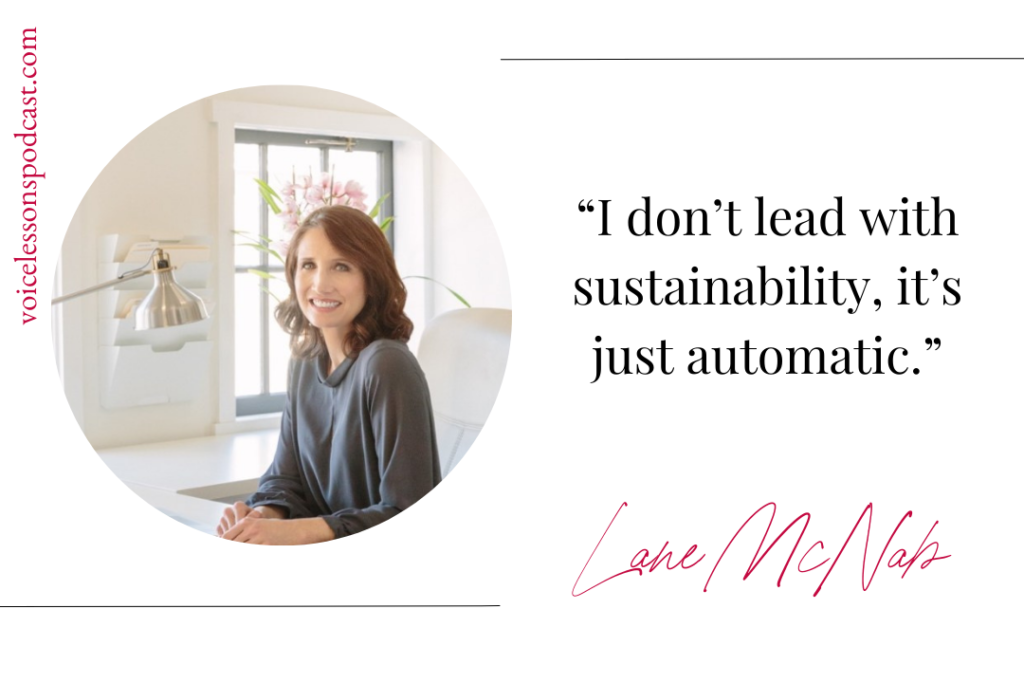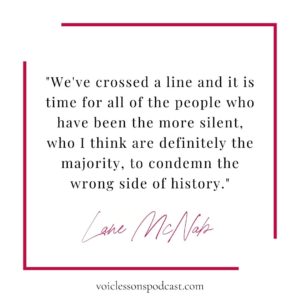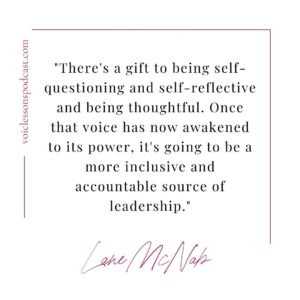A Lesson On Living Your Own Story with Lane McNab
Opera Singer turned Interior Design Founder @lanemcnabinteriors runs a thriving interior design firm and sustainable furniture company that is creating the next generation of heirlooms. How did she get there? By giving herself permission to keep embody her life and creativity fully.
Opera Singer turned Interior Design Founder runs a thriving interior design firm and sustainable furniture company that is creating the next generation of heirlooms. How did she get there? By giving herself permission to keep embody her life and creativity fully. In this Lesson on Living Your Own Story, Kim talks about her early working relationship with Lane, how Lane built her firm as a designer, and how she’s embraced her role as both a mother and creative and industry leader.
 Graduating with advanced degrees in vocal performance at San Francisco Conservatory of Music, Lane McNab pursued her music career spending several years as a highly-acclaimed operatic soprano in leading roles throughout the Bay Area.
Graduating with advanced degrees in vocal performance at San Francisco Conservatory of Music, Lane McNab pursued her music career spending several years as a highly-acclaimed operatic soprano in leading roles throughout the Bay Area.After years of extensive travel and studies abroad, Lane left opera singing to manage the demands of a growing family. When she returned to the working world, she focused on her other artistic passion: designing interiors. Before founding Lane McNab Interiors in 2012, she apprenticed with a local design and construction firm as a designer and project manager which gave her invaluable hands-on experience and a deep knowledge of the design and construction process.
A continuously curious learner with a passion for beauty, uniqueness, detail, and quality Lane has created a firm with a team of like-minded professionals giving her a devoted clientele and close relationships with vendors and tradespeople throughout the Bay Area. Her designs have been featured in numerous publications and tastemaker sites. When not passionately pursuing design, Lane spends her free time with her three children and husband in their 115-year-old house in Berkeley, CA.
LISTEN: APPLE PODCASTS | STITCHER | SPOTIFY
TOPICS DISCUSSED IN THIS EPISODE:
- How creatives can embrace spirituality.
- Lane’s first profession was singing and how she made the transition into design.
- Why lane decided to go with a sustainable business model.
- What “sustainable” means to Lane.
- Creating timeless pieces.
- Dealing with pushback from customers regarding budget and premium offerings.
- Designing with purpose to make products more beneficial to the environment.
- Lane’s 3 principles to her business.
- Not using motherhood as an excuse to not be your full self.
- How Lane speaks to issues that are important to her while keeping her brand value and reputation in mind.
- Being a mom and creative entrepreneur.
- How the shift happened for Lane to embody her own story.
- Transitioning from one career to the other.
- How women can step up and make their vision a priority, even in a family unit.
- How Lane views feminine leadership.
- How we can use feminine leadership to align principles with practices.
RESOURCES/ADDITIONAL INFORMATION:
EPA Reports 9.8 Million Tons Per Year in Furniture Waste
#LESSONUP:
(10:03:12:09) I had a client. This was not through the contractor. This was just kind of a friend of my husband’s from childhood. And I did his bachelor condo and that project, it was the very early days of Houzz. And because we’re in the tech world out here in the bay area, I knew of houses. My husband had said, oh, I’ve heard about this new website. You should get involved in it. So I signed up for Houzz. I put that project online as well as our home. And I started just getting a lot of hits from it and Houzz was asking me to write articles. And so then that bachelor project actually got picked up by the Today Show Website. I had taken those photos for it, with my old Canon Rebel. You can actually see me in the reflection of the photos and that got posted with like David Bromstad and that was sort of my wake-up call that so say, okay, this is happening. And then I started getting inquiries and I hired someone to help me get my business side going, and just sort of advise me how to do this. And so I did that and I made my first hire. And then not long after that, I got my first multi-million dollar project. A lot of it’s timing. A lot of it’s being open and a lot of it’s just putting yourself out there. When I saw it taking off, I decided to really get in front of it.
(13:50-15:15) The sustainable name I am very serious about and I’m very careful with it because I feel like, and this gets a lot into more spiritual stuff, but I feel like there’s a tendency to use it right now as a greenwashing kind of marketing tool. And I think if you really are serious about it, as we are, it requires constant critical thinking and analysis and improvement. And that’s what we’re doing all the time. The more you the better you do and when you know better, you do better. And that’s what I’m constantly trying to do with this line. And I think succeeding, but it makes it incredibly hard. So the line I developed about three or so years ago, the sketches, again, I just sat down in a week, drew everything for the furniture line, and then had them. And I was like, now, what do I do? We worked with a lot of local production workrooms. And because my firm had been shifting more and more towards sustainability or environmental stewardship and what we were proposing to clients, it was an easy choice to make, to say, well, if this is what we’re producing as something we are owning as ours, then that has to be an integral part of it.
(16:17- 17:30) We bought up a large batch of reclaimed white oak that is part of structures that were built in the 17 and 18 hundreds. And when those trees were cut down, they were probably 400 years old. There is no old-growth really anymore. So we’re talking about wood that’s potentially seven to 800 years old, and we have that and it’s a completely different type of aesthetic. It’s gorgeous. It’s dense. The same tables that we make. Let’s say our little side tables. If we make it out of the reclaimed, it’s about twice as heavy because the wood is so much denser because it’s existed for so long. The grain is so tight. It actually broke our carpenter’s saw the first time he cut into it. It’s amazing. It’s gorgeous. And it tells a story. And that’s, I mean, that’s a bonus too. I mean, you’re touching something that’s been touched by hands hundreds of years ago. So I love that we have that as an offering. We also, the new wood, which has a different look is FSC certified, all sustainably managed forests. And actually from the Pacific Northwest.
(19:47-20:51) That’s actually why quality is the first principle of the line because I have had clients who come to me and say, I want sustainability, but not if it’s going to up the budget. Well, that’s off the table with me because I don’t even talk about it. I’m going to show you and present to you, not just out of my furniture line, but I’m a designer who works at that quality level anyway. So we automatically incorporate that into what we do. And I tell clients, even in our intake calls, we present aspirationally. A client’s gonna tell me their budget and I will respect it and obviously we filter through budgets anyway. But if I know that there’s a piece that is a much better piece for the project, and it’s pushing the budget, I’m going to show it to the client, and then it’s their choice. So don’t lead with sustainability. It’s just automatic.
(22:40-23:42) I try really hard to be thoughtful in what I put out into the world, but the riot on the Capitol just really put a line in the sand. And I felt like this is ridiculous. And if we are not publicly stating or condemning or supporting what is right in this moment, then you are absolutely putting yourself on the other side. And that just became very clear and apparent. And I don’t know if you know my thinking about not wanting to join the fray prior to that actually had any impact when I finally did speak up, but we’ve crossed a line and it is time for all of the people who have been the more silent, I think definitely majority, to condemn the wrong side of history right now.
(24:18-25:55) The one that popped up for letting go of the responsibility of, I guess, motherhood is a way to describe it, but it was also just all of the stuff I was taught to care about as a woman that I was kind of making myself care about and I can’t say, I always really felt like it was a priority was we’re in triage. And so it was like if I looked around and it wasn’t really a value to me, and not only a business value, because that was a big part of it too. I wanted to have my professional life and I wanted to cultivate that. And I wanted to have my creativity filtered through that or invested in that. But it was also like, do I really want to go nag my kids about picking up the stuff, or do I want to sit down and spend time with them? And it was sort of understanding the triage was just like the word we weren’t really like hemorrhaging or anything, but it was just sort of my like internally, I don’t care if everything is perfect, as long as I’m getting value out of that moment. So that was what opened up that permission to start to let go of a lot of that stuff that I felt had always been my responsibility and to just free it up for what was actually important.
(30:36-31:57) I don’t know if everyone senses it the way probably you and I do, but there’s definitely an awakening happening and it’s been happening for a while and women have too, not even just women. I know feminine can apply to the way men do things as well. There’s something that women have been gifted with through millennia of not being equally voiced in society. And there has been, obviously that is repressive, but there’s also a skill set that you develop just to survive. And that gets passed through generations. And now that we are waking up and claiming power, this sort of superpower that we have is going to be a part of how we lead. And so I think I think feminine leadership involves much more strategic and critical thinking much more self-reflection and much more long-term planning instead of just sort of like, I am here, I exist, this is what I want to do.
(32:10-33:25) This is not to make enemies out of men. They are very much becoming our allies more and more, at least the ones that have, that are open to the feminine paradigm. But there’s typically taught from birth, especially white men I would say that they have value because they exist. And I think other people at the table have to find where their value is that puts you in a different mindset. And if there’s a gift to being a little bit self-questioning and self-reflective, and being thoughtful, once that voice has now awakened to its power, it’s going to be a more inclusive and accountable source of leadership. The issue that we are finding right now within, especially within the business world, is that there was sort of an attempt at feminine leadership, but done in a masculine way in the early 2000 in particular. And that was sort of like marketing masquerading as mission. And I think we’re seeing the struggle with that right now.
(34:55-35:24) You can’t just have a mission blanket your not great deeds. And so I think that that has to be something that feminine leadership has to constantly be thinking about and ensuring that their principals are aligning with their practices. And I think that that’s something that feminine leadership will do a more masculine is sort of like we said, we’re doing this. Let’s just move forward because here’s our profit.
PIN IT:


A Lesson On Living Your Own Story with Lane McNab
VIEW THE COMMENTS